While unimportant to some, board game box size can be crucial. Whether it’s practicality, price or another consideration, it can actually make or break a game. Both in terms of sales and reputation. But with each game, you’ll find people on both sides of the argument. So what’s all the fuss about?
Too big?
Oversized boxes can look brilliant. And they take up more store shelf space, giving browsers more chance to pick them from a crowd. Many games simply need them due to the components simply fitting in them. From Agricola or Terra Mystica, to Junk Art or Tumblin’ Dice, you couldn’t squeeze much more in. And shrinking their components would clearly be detrimental to the play experience. So no arguments there. But other games rattle around in a big box for no reason. Or upscale relatively basic components to give the impression of being more than they are. There are many examples. But the ones on my mind recently have been Abyss (2014), Lift Off (2018) and Isle of Cats (2019).
Abyss and Lift Off both look brilliant on the table. And are well designed, fun games. But at £40-50 (roughly, via Board Game Prices) its hard to argue they offer good value. Because, essentially, both are relatively straightforward card games with pasted-on themes. Either could probably have been released in a box half the size for around half the price. Isle of Cats is arguably a worse offender. Again, the box is nice and the components look great on the table. But they don’t even take up half the box size. And no attempt was made to even bother putting in an insert. So again, at around £40, it’s hard to recommend.
And in each case, it also needs to be remembered not everyone has unlimited space. Many players operate a one-in, one-out policy sue to shelf space. Or perhaps because their partner/family feel they need to put a physical cap on their hobby. So while many of the most vocal in the hobby tend to have game garages or rooms, the much larger majority have a shelf or corner. It’s a very real practical problem.
Board game box size: Too small?
This can give players a disappointing experience, because they were expecting something more. So make a small game, right? Cheap price point plus no storage issues. As long as you get your game out there under people’s noses, they’ll buy. And it should get played more, because you pop it in your pocket for a trip, fill in a suitcase gap etc. And most people shop online now anyway. But again, it isn’t quite that simple.
Firstly, you usually give up some wow appeal - which can badly affect word-of-mouth as well as great first impressions from seeing a game in play. And its harder for many players to take a game as seriously if it’s in a small box. Small box means filler to most - although it doesn’t have to. Great euro games such as 1906 San Fransisco have proved you can squeeze a quality game into a small package. But its not where you look on your shelves for your main game of the evening, is it?
Not being taken seriously as a ‘proper’ game (thanks to your small box size) also clearly affects Board Game Geek (BGG) ratings. Which I’d suggest is a key factor in many buying decisions within the hobby. BGG gives guidelines on how to rate (out of 10), which clearly suggest basing the rating on enjoyment and how good the game is. But the fact some of the game’s most played titles (Can’t Stop, 6 Nimmt! etc) can’t break the Top 500 games shows a clear user ranking bias towards showy components and complexity.
Boxing clever
Ultimately, if a game doesn’t have an obvious box size, publishers are taking a big risk in going either way. I was astounded at how little game their was in the box for Abyss, for example. Despite it being a good game. And similarly with the criminally overrated Splendor (which I find tedious). But the oversized box in both cases has helped them become big hits. Isle of Cats, too, has made a strong impression on the hobby market in terms of ratings.
Should it matter that you’re not getting value in terms of game, when you are in terms of components? That is an individual customer decision. And one that seems to be moving inexorably towards the pretty over the practical. When I came into the hobby 10 years ago, a £40 price tag had you wincing in pain. Now, spaffing £100 on an undefined lump of Kickstarter gamble seems par for the course. Who’d be a publisher…?

